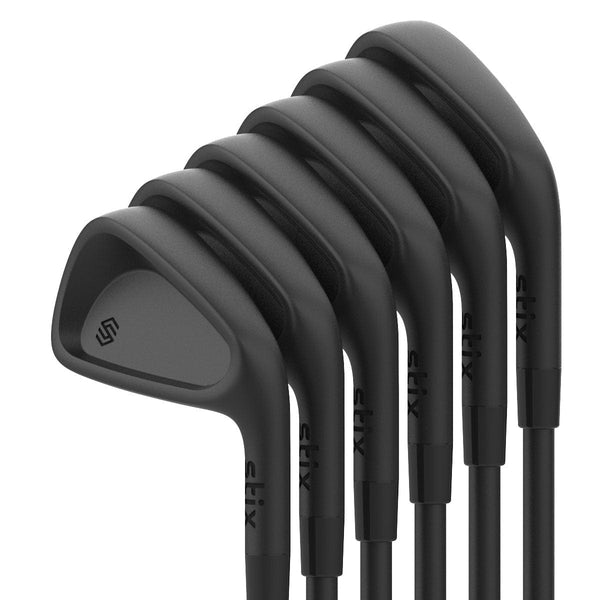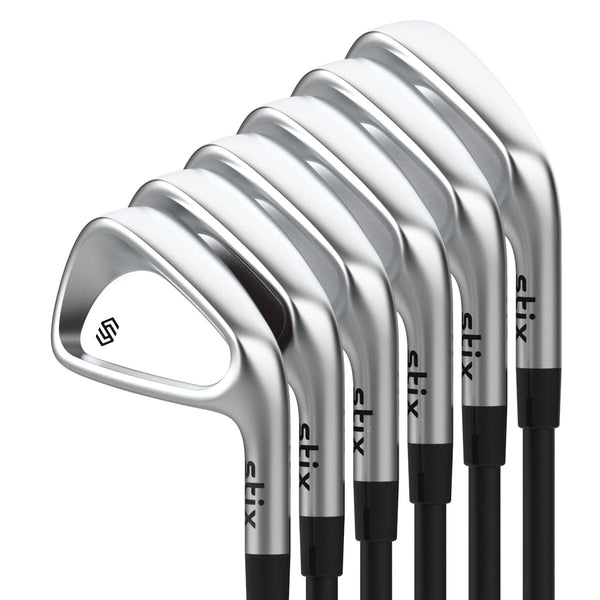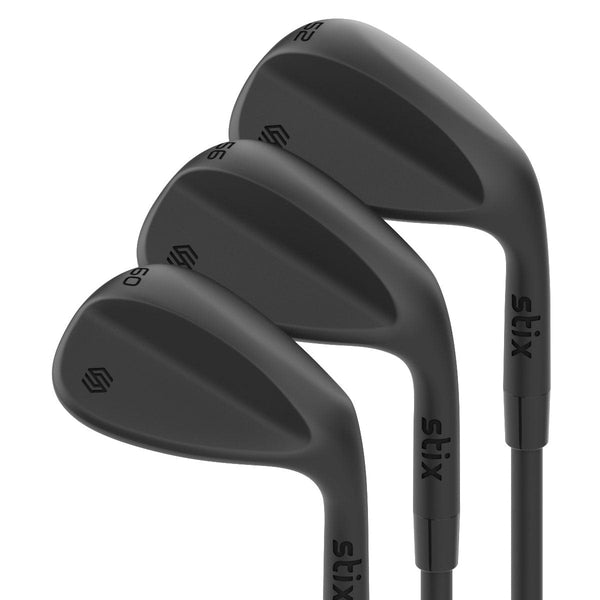Steel shafts and graphite shafts are the two main options when choosing shaft materials for golf clubs. Each type of shaft has its own set of benefits, and the choice between them depends on your playing style, skill level, and personal preferences. It might seem like a tricky choice for a beginner, which is why we’ve put together a guide that highlights the differences between these shaft types and their respective benefits. Read on to learn about steel and graphite shafts and how to choose between them for your next set of clubs.
What is a Steel Golf Club Shaft?
Steel golf club shafts are typically made from carbon steel (or occasionally stainless steel) and are known for their durability and consistency. Steel has been used for golf club shafts for many decades, dating back to the early 20th century. The transition from hickory wood shafts to steel shafts marked a significant advancement in the design and performance of golf clubs.
The specific alloys and manufacturing processes used to create steel golf shafts have evolved over time, leading to shafts with varying characteristics such as flex, weight, and kickpoint. These advancements have allowed golfers to customize their clubs to suit their individual swing preferences.
Steel golf club shafts now come in various flex profiles, such as stiff, regular, and senior, to accommodate different golfers' swing speeds and preferences. Steel shafts are generally heavier and offer less flex than graphite shafts. This can lead to more control and accuracy for some golfers, especially those with faster swing speeds.
What is a Graphite Golf Club Shaft?
A graphite club shaft is a type of golf club shaft made from a composite material called graphite, which is a lightweight and durable material. Graphite shafts were first developed in the 60s and 70s as a lightweight alternative to steel shaft golf clubs.
Graphite shafts are significantly lighter than steel shafts. This reduced weight can help golfers, especially beginner golfers, generate more clubhead speed, potentially leading to greater distance off the tee and fairway. While steel shafts are still popular for irons and wedges due to their control and consistency, graphite shafts have become a common choice for drivers, fairway woods, and hybrids, offering a blend of performance and comfort.
Benefits of a Steel Shaft Golf Club
Steel has been a fundamental component of golf club structure for decades – for good reason. Here are some of the biggest advantages of a steel shaft golf club.
Greater Control
Steel shafts are known for their stiffness and consistency. This stiffness can provide greater control over your shots, especially for golfers with a faster and more aggressive swing tempo. It can help with shot shaping and precise shot placement.
Durable
Steel shafts are highly durable and can withstand the rigors of the golf course for many seasons. They are less prone to breaking or becoming damaged compared to graphite shafts, which can be a consideration for golfers who play frequently or in various conditions.
Consistent
Steel shafts have a more consistent flex profile throughout the swing, which can lead to more consistent ball flight and distance control. This consistency is valued by many accomplished golfers who require precise shotmaking.
Feedback
Steel shafts provide a more direct and pronounced feedback sensation to the golfer's hands during the swing. This feedback can be helpful for golfers looking to improve their swing mechanics and tempo.
Versatile
Steel shafts are commonly used in irons, wedges, and putters, where control and accuracy are critical. They are well-suited for approach shots, chip shots, and putting strokes.
Benefits of a Graphite Shaft Golf Club
Graphite is an excellent alternative to steel shaft golf clubs and brings many unique benefits to the table.
Lightweight
Graphite shafts are significantly lighter than steel shafts. This reduced weight can help golfers generate higher clubhead speeds, leading to longer drives and increased distance. Lighter shafts can also decrease fatigue while playing long rounds.
Flexible
Graphite shafts are more flexible than steel shafts simply due to their construction. Greater shaft flexibility is great for golfers with a slower swing speed as it helps to build power and momentum during your swing.
Shock Absorbing
Graphite shafts are excellent at absorbing vibrations generated during impact. This feature can help reduce the strain on a golfer's hands, wrists, and arms, making them a good choice for players with joint issues or seeking a more comfortable feel.
Customizable
Graphite shafts offer more customization options in terms of shaft weight, torque, and kickpoint. Golfers can fine-tune their club's performance to suit their preferences and playing style.
Full Sets vs. Individual Clubs
As a general rule, it’s usually more cost-effective to buy golf club sets than it is to buy each club individually. However, golfers who really want to dial in their game might want to consider mixing graphite and steel shaft clubs in their golf bags.
Best Clubs with Steel Shafts
Steel shafts are traditionally favored for certain types of clubs due to their control and consistency. Here are the clubs that are often preferred with steel shafts.
Irons
Irons with steel shafts provide better control and accuracy, making them suitable for approach shots and shots where precision is crucial. Many professional golfers and low-handicap players prefer steel shafts in their irons to achieve consistent ball flight and distance control.
Wedges
Similar to irons, wedges are often fitted with steel shafts. Steel shafts in wedges provide the golfer with the ability to execute delicate shots around the green, as well as full swings for approach shots. The control and consistency offered by steel shafts can be advantageous in these situations.
Putters
While the shaft material in putters is less critical compared to other clubs, some golfers prefer steel shafts in their putters for the added stability and consistency they offer.
Best Clubs with Graphite Shafts
Graphite shafts are commonly used in specific types of golf clubs where their lightweight and flexible characteristics are advantageous. Here are some of the clubs that are often fitted with graphite shafts.
Drivers
Graphite shafts are extremely popular in drivers. The lightweight nature of graphite allows for increased clubhead speed, which can result in greater distance off the tee. Additionally, the flexibility of graphite shafts can help promote a higher launch angle, ideal for achieving maximum carry and distance.
Fairway Woods
Many golfers prefer graphite shafts in their fairway woods, especially for clubs with higher lofts, such as 3-woods and 5-woods. The added clubhead speed and flexibility can help golfers hit these clubs off the fairway and rough more effectively.
Hybrids
Graphite shafts are a common choice for hybrid clubs, which are designed to replace long irons. The lightweight and flexibility of graphite can make it easier to get the ball airborne and achieve more consistent results from various lies.
Learn more: Driver vs. 3 Wood Off the Tee: What Should You Use and Why
Stix Does Steel?
Up until now, Stix has exclusively used graphite to make our clubs – but all that is about to change.
Stix Golf’s goal is to provide our customers with the highest quality products at an accessible price so more people can enjoy golf more. For a long time, our customers have been asking for steel shafts to further dial in their golf game. That’s why we're launching a new set option. The Stix Perform Series comes with black stepless steel shafts on irons & wedges in the 14-club and 11-club sets. We've also made some improvements to our graphite shaft offering on all distance clubs, and we’ve updated our head covers, which are included with every set purchase.
You might also like:






